A challenge to the balance
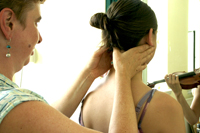
All musicians must maintain their equilibrium in order to play their instrument. Violinists and violists have a special challenge to their balance because their instrument is held at neck level. Holding their instrument necessarily involves neck and head, where basic balance mechanisms reside.
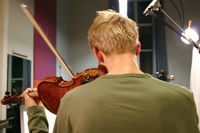
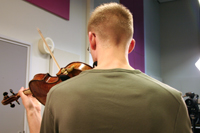
1. Before the research. Huug, Nov. 2003
2. At the end of the research, after re-training and equipment adjustments. Huug, June 2004
Constantly contracting the neck muscles affects the balance of the entire body and the functioning of the arms, hands, back and legs.
An ill-fitting chin rest and shoulder rest, combined with an instrument positioned awkwardly, make it difficult to play with grace and ease. After several years of playing with ill-fitting equipment, violinists and violists can develop the habit of constantly contracting neck and shoulder muscles while playing. This can lead to distorted habits of standing or sitting in which the head is no longer balanced on top of the spine.
A player accustomed to a cramped position comes to experience this as normal. Even when he is not playing his instrument, he often walks with tilted head and left shoulder raised. Because his constant playing tension and crooked head feels normal, he cannot find the poise that he has lost.
“My head had to go down so much to find the violin that my neck got more and more tense, but it was a kind of tension that I was used to.” – Daniel
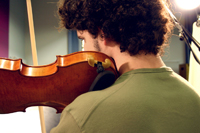
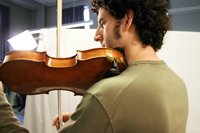
1. Head pulled down, neck shortened. Mikkel before the research, Nov. ’03
2. Head re-aligned on top of spine, neck lengthened. Mikkel the end of the research, June ‘04
Posture problems?
The struggle to hold and play the instrument when equipment is not properly adjusted can result in leaning far forward while playing, twisting the back, throwing the upper body backwards, or shortening the neck by pulling the head down. Often these results are seen as purely “posture problems” when they are really the reactions of a normal body to unnatural circumstances. Referring to a “good” or “bad” posture puts blame on the musician by placing emphasis on what they are doing wrong instead of why things are going wrong. This attitude treats the symptoms and not the cause. Instead, one should look seriously at what prevents the player from using muscles and joints in a healthy way.
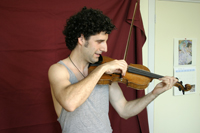
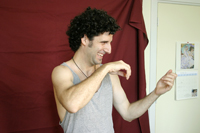
1. What looks normal to us with the violin…
2. …looks cramped when instrument is removed.
The public is used to seeing the violinist contracted around the instrument. We even sometimes think that a cramped style of playing looks more expressive. It’s no wonder that musicians themselves often feel that unnecessary contractions are an integral part of playing their instrument.
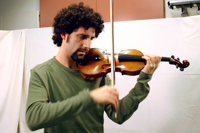
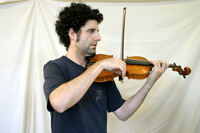
1. Mikkel before the research, Nov. ’03
2. Mikkel after the research, June ’05
Psychological or Physical?
Confusion between what is “psychological” and “physical” is also common. Who would not exhibit symptoms of “a nervous disposition” if their neck was held tight in one cramping position several hours a day? Whose courage or spirits would not begin to flag when pain or injury threatens their chosen beloved career path? Musicians who admit to having “problems” are often social outcasts in their profession. Fear of discovery keeps them from seeking help, as fear of a similar fate or ignorance of possible solutions may keep their colleagues, teachers, management or health care professionals from addressing the issue in a constructive way.
Among the musicians in our research, the relief of being able to move and play freely was both psychological and physical.
>>The Experience
